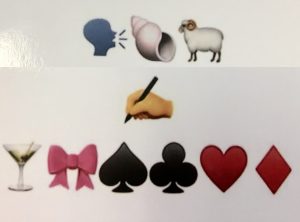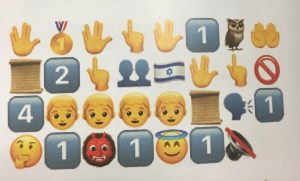I recently had occasion to review the Passover Haggadah Graphic Novel, which represents a novel approach to the traditional Seder text. Almost immediately upon completing this task, another unusual take on the Haggadah was brought to my attention for potential review: Martin Bodek’s The Emoji Haggadah. If a Haggadah in graphic novel format strikes you as outside the box, rest assured that an all-emoji Haggadah not only leaves the box, it folds the box up neatly and puts it outside for collection.
It’s a Haggadah. Written in emojis. Completely.
Look at this text from the cover.

It says:
Haggadah shel Pesach
Written by
Martin Bodek
Here’s the first line of Kiddush:

And it was evening and it was morning – the sixth day. And the Heavens and the Earth were completed…
Okay, now you try one:

Did you get it?
“Baruch HaMakom Baruch Hu – blessed is the one Who gave the Torah to His people, Israel, blessed be He. The Torah speaks corresponding to four sons: one wise, one wicked, one simple and one who doesn’t know how to ask….”
Reading up on the author a bit online, Bodek appears to be a fairly prolific writer. While I have not yet read any of his other books, I appreciate that they all seem to be very different from one another. Bodek is no one-trick pony, a fact he reiterates with The Emoji Haggadah, another unique offering.
Frankly, I’m impressed with Bodek’s commitment to his craft. With the exception of the spine text and the UPC symbol, literally everything is in emojis – the contents, the dedication, the “about the author,” even the copyright page. (There are a few pieces I haven’t decoded yet.)
So do I recommend it? That depends on what you intend to use it for!
If you are a Haggadah collector, as many people appear to be, then you absolutely need this. Your collection simply will not be complete without it.
If you are a puzzle fanatic or a code enthusiast who is also familiar with the basic “plot” of the Haggadah, then you will also have a lot of fun deciphering this book.
If you’re looking to sit down to the Seder and need a Haggadah… well, this may not be the most practical option on the shelf. (It should be noted that, while the edition I have is pure emojis from to cover to cover, a new edition has been brought to my attention that is 50+ pages thicker. This newer printing includes tips for decoding the emoji-speak plus the full traditional text of the Haggadah in Hebrew and English. That kind of takes care of my one reservation – the book’s utter uselessness for use as an actual Haggadah – but not having seen the version with text in the back, I can’t really comment on it.)
Honestly, useful at the Seder or not, The Emoji Haggadah has been quite the conversation starter on my desk. I can only imagine that it will have the same effect on your coffee table.
The newest edition of The Emoji Haggadah – the one I haven’t yet seen – is published by KTAV and is available on Amazon.
—————————–
Addendum: Pursuant to my posting this review, the author sent me a copy of the appendices, “How to Read This Book, in 14 Plain Steps” and a glossary of the 20 most common emojis in the Haggadah. From these appendices, we learn such facts as (spoilers!): there is no emoji for matzah, so Bodek used the universal symbol for “no” plus bread; the number 4 + an evergreen = forever; an emoji used twice means that a word is plural; Yaakov means “heel,” so he’s represented by a shoe emoji; the US flag means “us”; etc. This is like when the cryptogram in the newspaper (remember newspapers?) would give you the first five letters – it’s still a fun puzzle but not quite as frustrating for those of us not at an advanced level.
Rabbi Jack Abramowitz is Torah Content Editor at the Orthodox Union. He is the author of six books, including The Tzniyus Book and The Taryag Companion. His latest work, The God Book, is available from OU Press as well as on Amazon.
The words of this author reflect his/her own opinions and do not necessarily represent the official position of the Orthodox Union.
